It was late in the afternoon when we left Bangkok and arrived at Phuket Airport. From the window of the aircraft, we could already admire the beaches and got excited, while wondering what the following days would bring. It is always a strange feeling when we leave a place. We get used to an area but shortly after we need to start again orientating ourselves in a new place. Still, we found it easier this time.
The friendly receptionist at our hostel already informed us in advance about the different ways to reach the little city from the airport. We decided to take the airport bus that cost us 100 Bath for a distance of around 30 km, which was the cheapest way to get to the city.
Phuket
Ko Phuket (Ko means island) is located in the south of Thailand and spreads over 543 km², which makes it the biggest island of the country.
Phuket is a touristic hot spot for all kinds of travelers. You will find here families, backpackers, luxury travelers, foreigners living on the Island and people looking for beach escapes or enjoying the colonial city life in Phuket town. Therefore Phuket offers all kinds of attractions and generally at higher prices than in other parts of the country.
Patong Beach
After the warm welcome at the hostel and good sleep at night, the following day we enjoyed a big cup of coffee at the coffee shop next door where we planned our first day on the island.
We decided to use the local bus to discover the nearest beach that was Patong Beach. When we arrived we understood instantly what the place was about. Honestly, I was a bit shocked seeing the crowds of people lying next to each other like sardines in a can. As we traveled to most of the destinations in the past nine months during low season, I felt a bit naive visiting the most touristic beach on the island and wondering why it was more crowded than I imagined it.
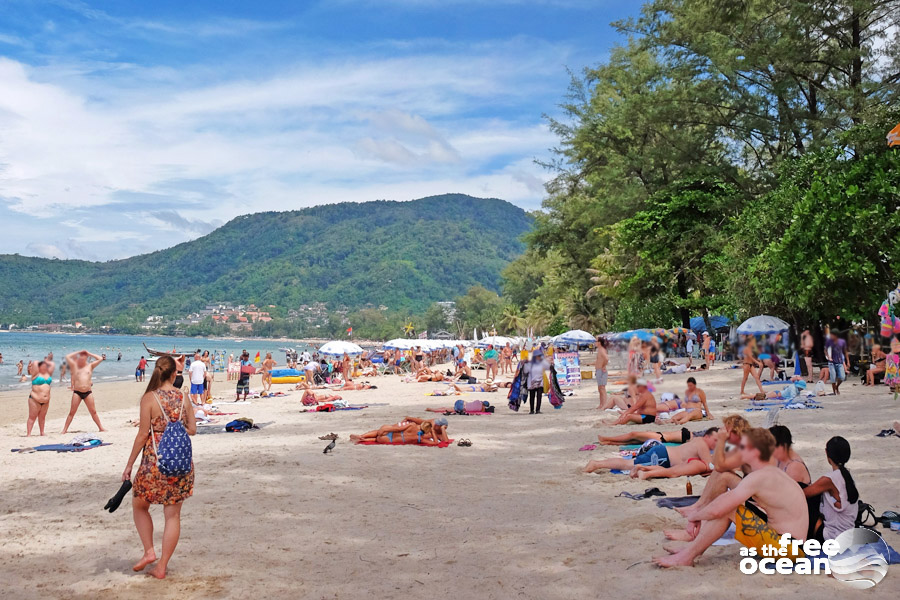
However, we walked around and enjoyed the sun, when we found a great beach club that offered for 200 Bath per person access to their pool and private beach, to free internet and cool music. The holiday mode switched on instantly and we enjoyed the place without hardly any other visitor.
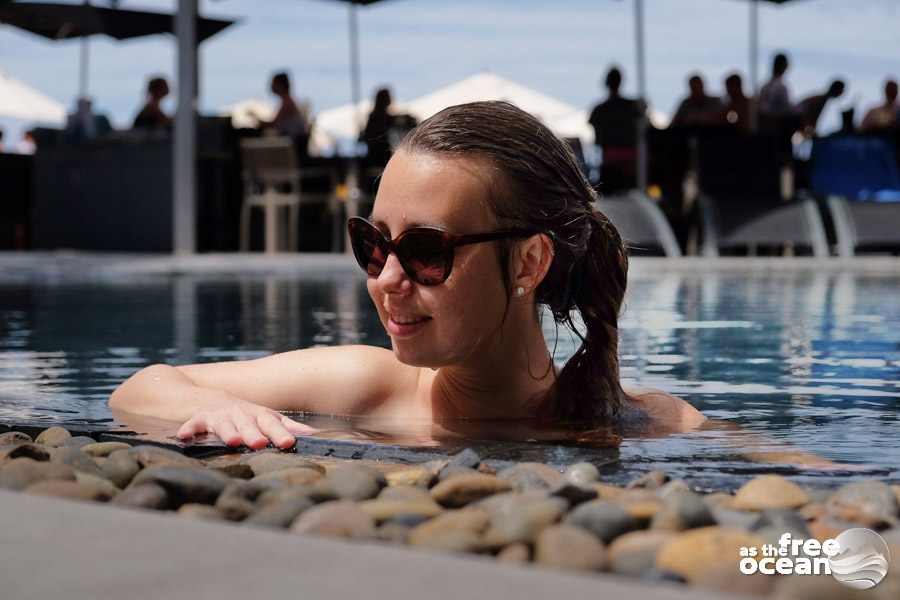
In the afternoon we took the bus back to Phuket Town for 30 Bath, which seemed fair for the distance that we traveled and later we enjoyed the evening on the colorful streets where a night market happened to take place the same day.
Weekend Night Market
Thailand is famous for its many various markets. After visiting the Floating Market in Bangkok we were curious about the night market that took place during our weekend in Phuket, starting from 4 pm to 9 pm. It felt nice to walk on the busy but colorful streets, observing the vendors, locals and visitors strolling around and enjoying themselves. The streets were filled with delicious food smells and music form the little shows that were performed.
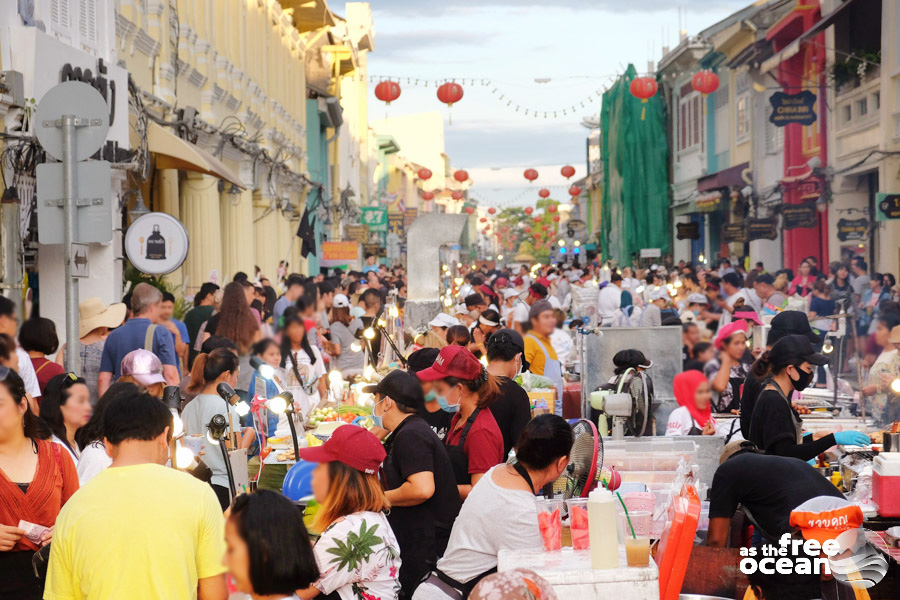
This place offered really everything, all kinds of Thai and Chinese dishes, clothes, souvenirs, art, etc. We enjoyed various snacks and were positively surprised by the low prices.
The second day was dedicated to exploring a bit more of the old town of Phuket, which impressed us with its colonial buildings and street art. The charm of the many coffee shops, cute boutiques, art galleries and international restaurants reminded us a bit on George Town in Malaysia.
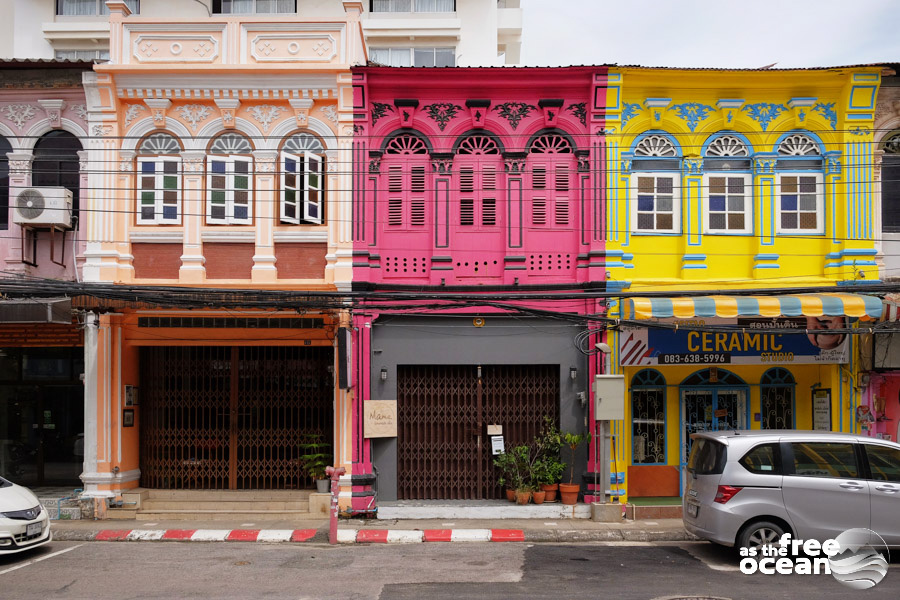
The perfect beach escape in Phuket
The last day we decided to see a bit more of the island that was covered in rich green colors as the monsoon just came to an end. We took again the bus, this time more south towards Rawai Beach. The bus driver let us out close to the pier where the boats set off to the surrounded islands.
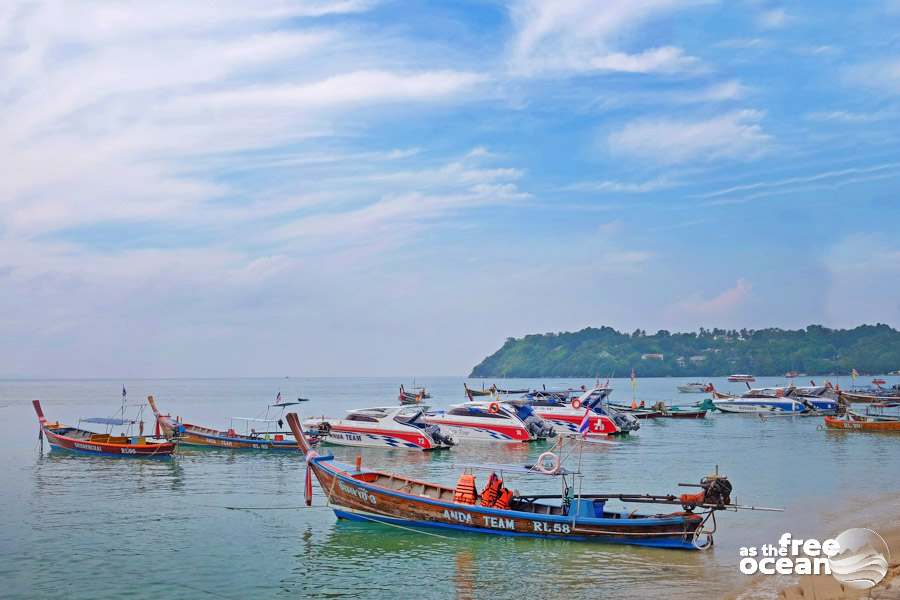
The coastal area was busy with boats offering tours. The many restaurants and shops reminded us a bit of Patong Beach but we understood quickly that the place was different, as hardly any people were around, mainly locals but not so many tourists.
The App Maps.Me guided us towards another little beach that we wanted to visit, just one kilometer further from where the boat drivers were waiting for tourists to arrive. After a nice walk, we reached a beautiful little beach and wondered why there was nobody else apart of us and a few locals that seemed to live there. We enjoyed a few quiet moments and I instantly forgot about the shock I got at Patong Beach.
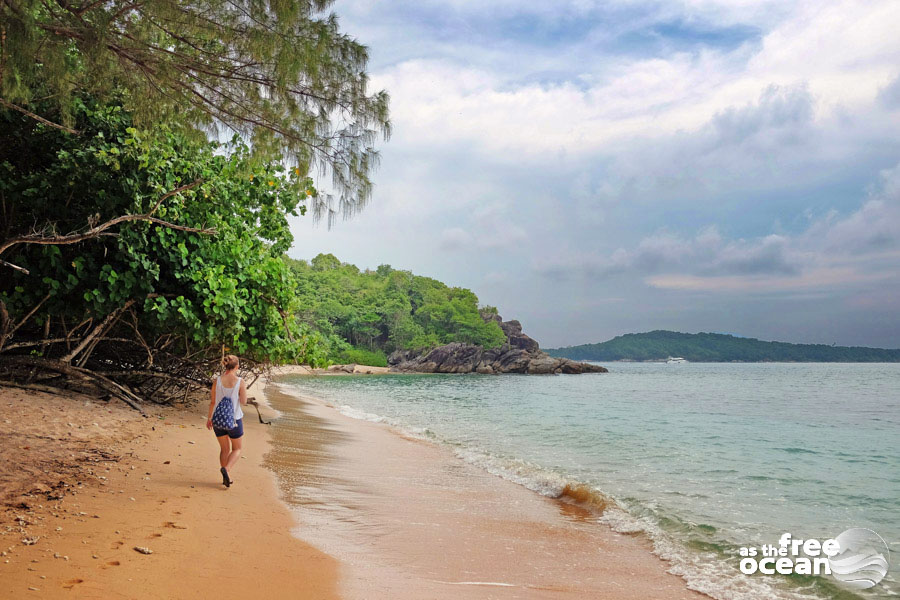
Later that evening we spent some time around one of the local markets in the town, where you could find cheap and authentic local food.
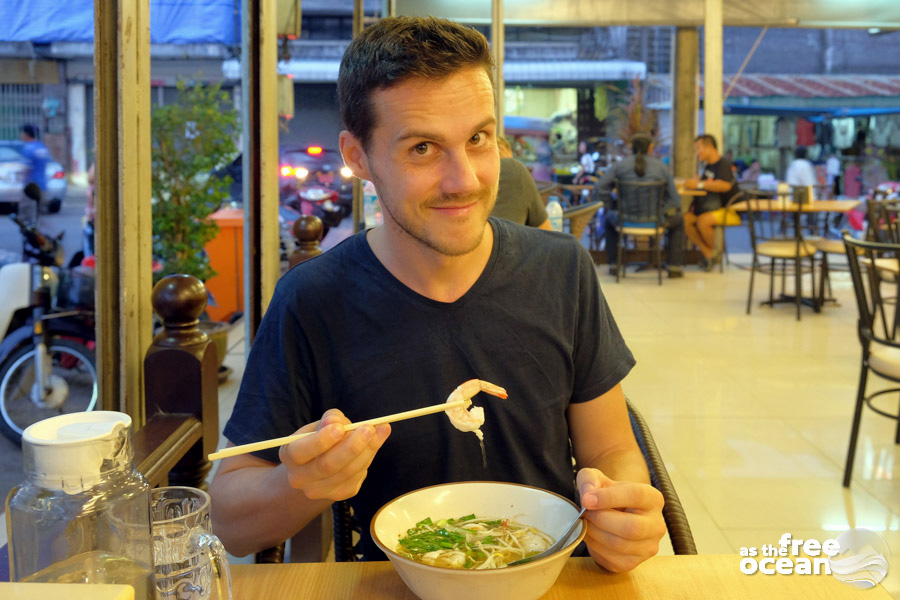
Overall, we can say that we had a great time in Phuket, but as budget travelers that also don’t feel like sharing places with the crowds, it didn’t fully feel like our type of place to be. Still, we will definitely return with more time to explore the north side of the island, as well as the Big Buddha Statue and some of the many small islands that surround Phuket.
Click here for more pictures from Phuket.
After returning home from Asia for a short break when we visited our families and friends, we traveled together for one week in Romania, where we had a few beautiful and warm late summer days that allowed us to enjoy our stay to its fullest and recharge our batteries. We explored the two beautiful Transylvanian cities Sibiu and Brasov and later traveled by train to the capital city from where we would take a night flight towards our following destination, Bangkok.
It was late in the evening when we left Bucharest. We packed our backpacks and took a taxi to the airport, after our last walk in the city when we admired the beautiful red and orange autumn colors.
Thailand, here we come
Our first flight brought us to Moscow, from where we flew after directly to Bangkok. It took us a bit of time at the immigration control upon arrival. Due to our different nationalities, we had to deal also with different visa requirements for Thailand, but all went fast and smooth. We were just in time to catch the Bangkok Airport Rail Link, a train line connecting Suvarnabhumi Airport with Phaya Thai. The journey took around 30 minutes and cost 45 Bath per person. As it was already late, we ordered a Grab car through our mobile app to bring us from the train station to our hostel.
The good location of the hostel allowed us to start directly with our sightseeing tour the following morning. We strolled around the streets of Bangkok, observing the many food stalls and hawkers selling their products. We immediately realized what a high amount and a big variety of street food are sold in Thailand.
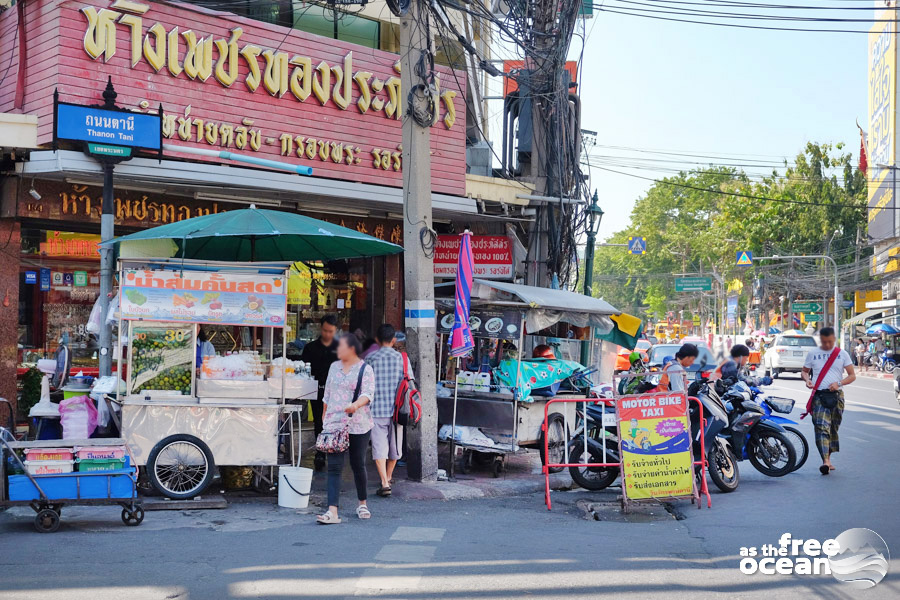
The excitement of returning to Asia
It was that first day when we realized how necessary our 3 weeks break at home was because we were able to feel again the excitement of exploring this part of the world as much as at the beginning of our big journey. We were more aware of the things happening around us and the feeling of adventure growing inside. We were back and ready to explore much more!
Bangkok felt surprisingly quiet compared to our last travel destination New Delhi, in India. No unnecessary use of the horn, no constant noise coming from people or animals… it was pleasant to be there, despite the fact that it was such a massive city.
Sightseeing in Bangkok
The walk led us towards the Grand Palace and later to the Buddhist temple Wat Pho, where we could admire a gigantic reclining Buddha.
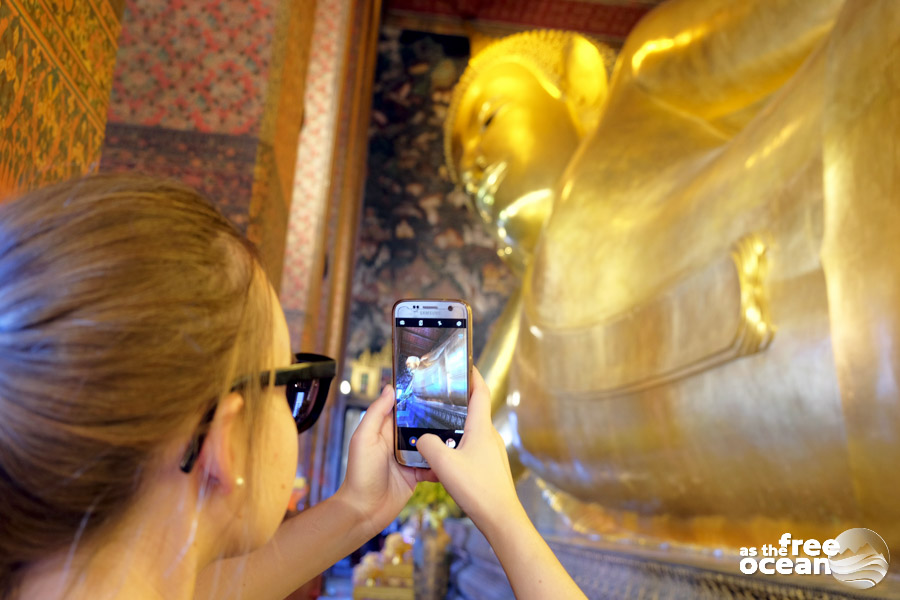
Wat Pho is one of the biggest temples in the city and besides the golden Buddha Statue, the complex offers much more to see. The Entrance fee was 100 Bath per person and it is highly recommended to wear appropriate clothing for the visit of the temple. Don’t forget to cover up your legs and shoulders.
The rest of the afternoon we walked around the central area and the nearby Saranrom Park, were we could hide from the heat and cool down in the presence of the irrigation system of the park, which felt necessary as the warm sun that welcomed us in Bangkok got quite strong in the afternoon.
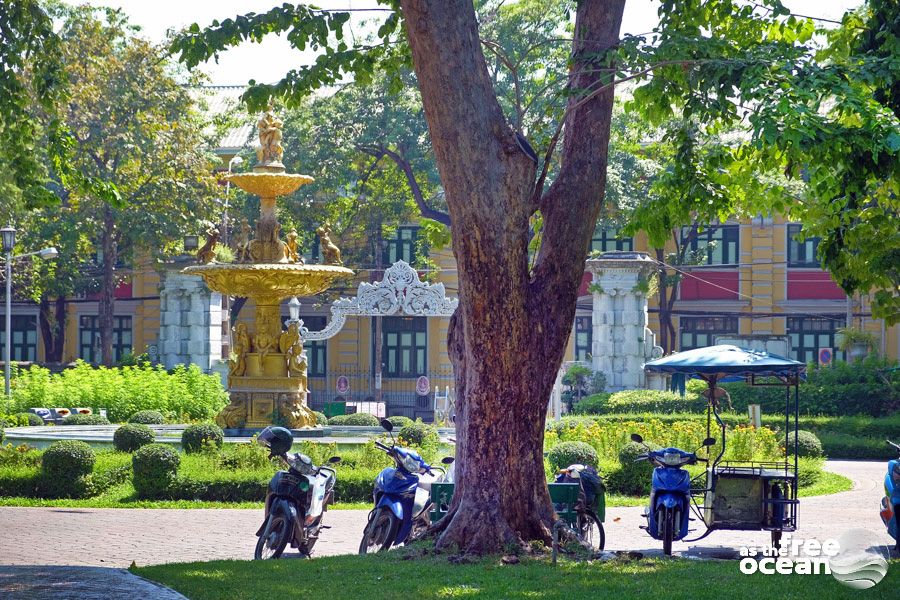
The following day we started again early, as our plan was to discover the west promenade of the Chao Phraya River, where another impressing building was waiting for us.
We crossed the river with the ferryboat at a cost of only 3.5 Bath per person, allowing us also to admire the city from another perspective.
On the other side, we walked along the river towards the Wat Arun Temple.
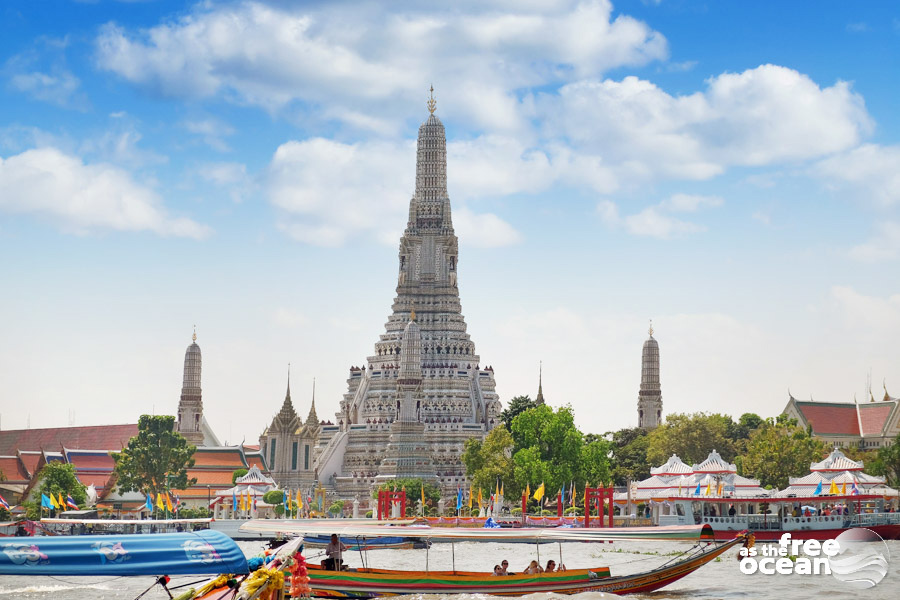
Wat Arun Temple
What makes Wat Arun so special is its Prang that contains 4 levels and is connected with stairs that offer a nice view over the city. The whole temple is covered by beautiful mosaic made out of little flowers of colorful Chinese porcelain.
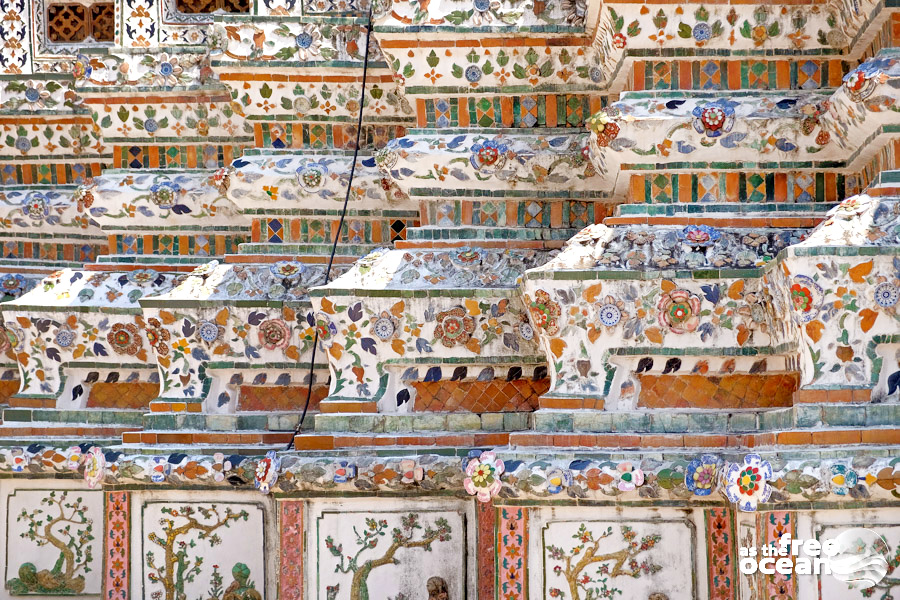
The entrance fee was only 50 Bath and I believe it is an absolute must-see when in Bangkok. By the way, the word „Wat“ stands for monastery or temple in Thailand, Laos and Cambodia.
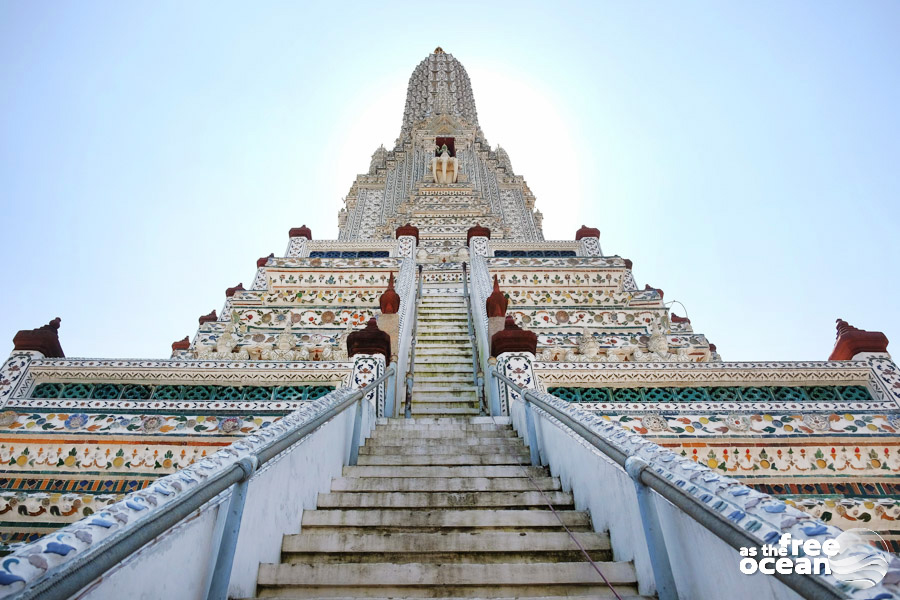
Our second day in this impulsive city passed very fast and the location of the nice hostel which we stayed in gave us lots of possibilities to try different dishes in the various restaurants around it. That evening we went early to bed as we had plans for our last morning in Bangkok, before our flight that was departing in the following evening.
Taling Chan Floating Market in Bangkok
It was 07.00am when we left the hostel and went towards Khosan Road, famous for its nightlife, from where we would catch the bus to the Taling Chan Floating Market. Bangkok can be easily discovered by using local buses. With the help of Google Maps, we could find out which bus to take and where to get off.
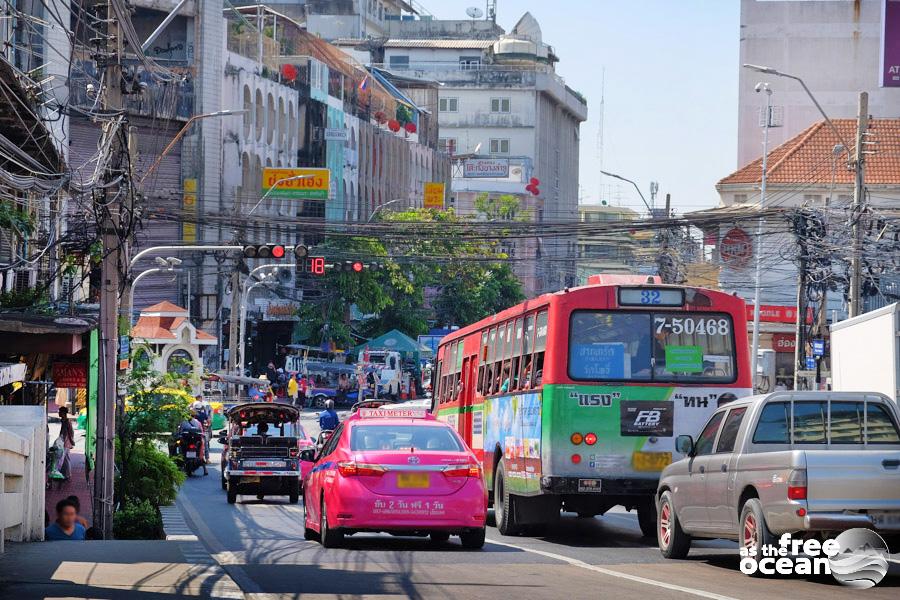
It was just 08.00 when we arrived at the Floating Market and we could observe the hawkers and sellers preparing their boats near the floating pier. The market was traditionally used in the past as the canals and rivers offered easy access to the farmers to sell their goods. Nowadays it is mainly a famous tourist attraction. There are many floating markets around Bangkok, but what we liked at Taling Chan is that the meals served were sold for a fair price and because in the morning it was not crowded at all. This place only opens during the weekend.
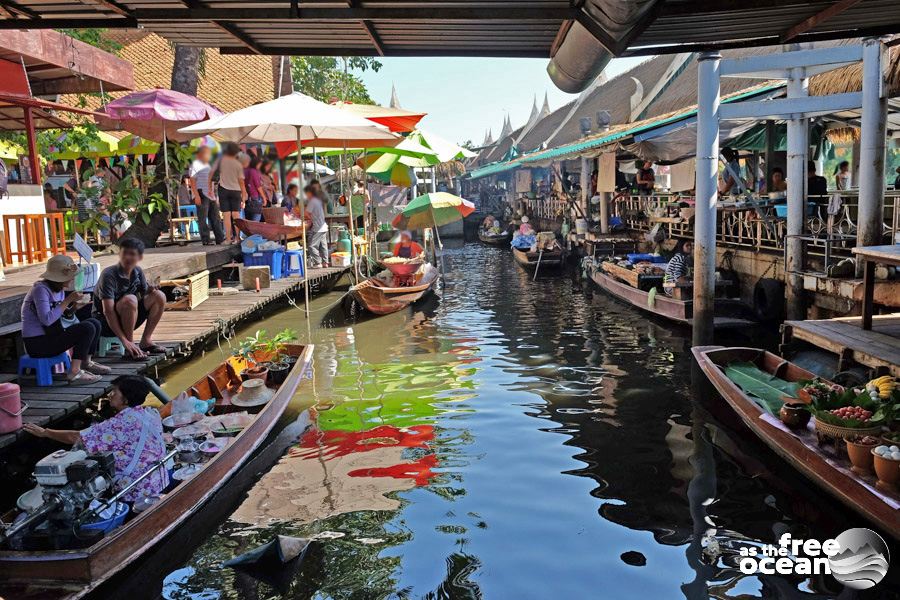
Later in the evening, it was time again to say goodbye and we made our way towards the airport to catch the flight to our next destination, Phuket.
See more pictures from Bangkok here.
We’ve heard all kinds of things about India long before deciding to explore it by ourselves. We listened to the stories of our Indian friends during the time that we spent on cruise ships and we spoke to travelers who visited India and who felt in love with it after traveling in the country long enough to understand it well. But we met also people that left India with negative impressions, people that could not adapt to the local habits and who described their visit as a “cultural shock”.
India is obviously not just another country in Asia, it has so many particularities that clearly separate it from any other country on the continent.
We can say now that India felt different while walking on its crowded streets than what we imagined before we arrived in Bangalore. And, with every new place that we traveled to, it seemed like there were more traffic, more garbage and more people trying to scam tourists. The picture that a traveler leaves with after a journey through India is definitely different than the one described by any travel agent or shown in any travel magazine.
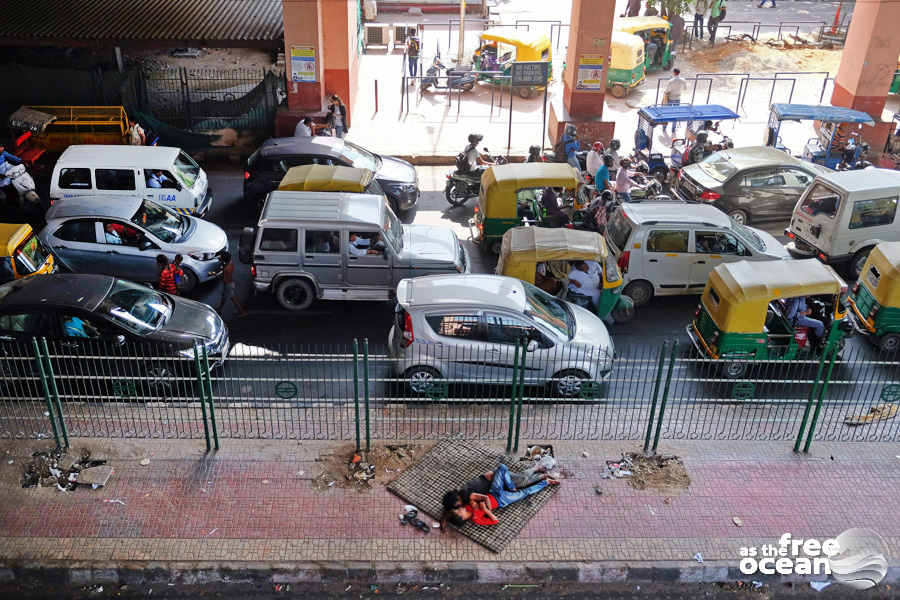
But perhaps “different” is not the right word to be used and “incomplete” is the one describing better the expectations of a first-time traveler in the country. People might tell you about the garbage and the smell, about the heavy traffic and the usually dirty surroundings. India is far from being a perfect country but it is for sure a beautiful destination. The diversity of landscapes that change dramatically while traveling from one side of the country to another, the mixed and strong traditions that survived for millenniums, the fascinating history and its rich culture make India a unique place to be.
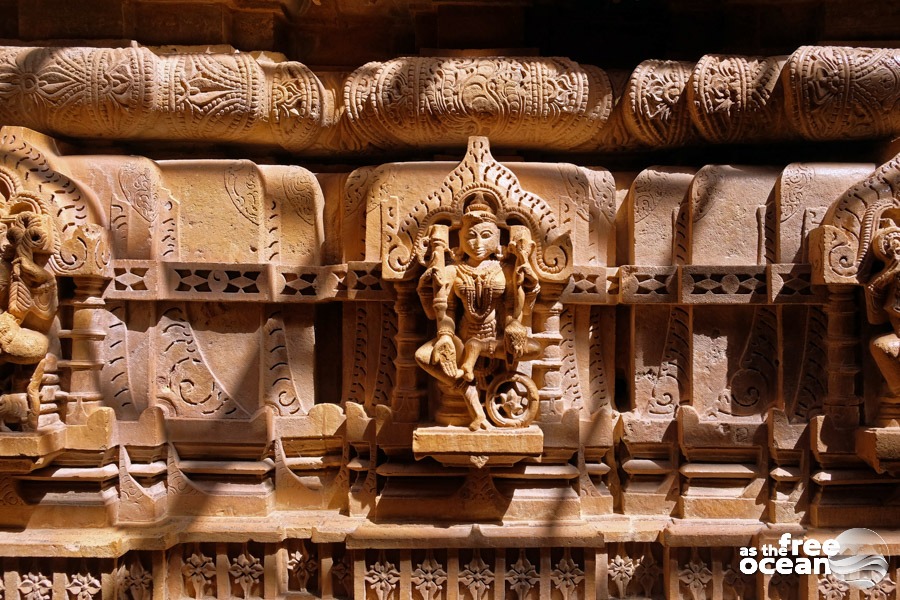
Unfortunately, beauty comes many times together with ugliness. We felt in love with India at the beginning but happily planned our escape at the end of our stay. When traveling in such a big country, one’s perception can vary very much from another’s, depending on where and how someone wants to experience India. We slept in luxurious rooms but we had also very simple accommodations… even spent a night out in the desert, with no roof above our heads, just the stars.
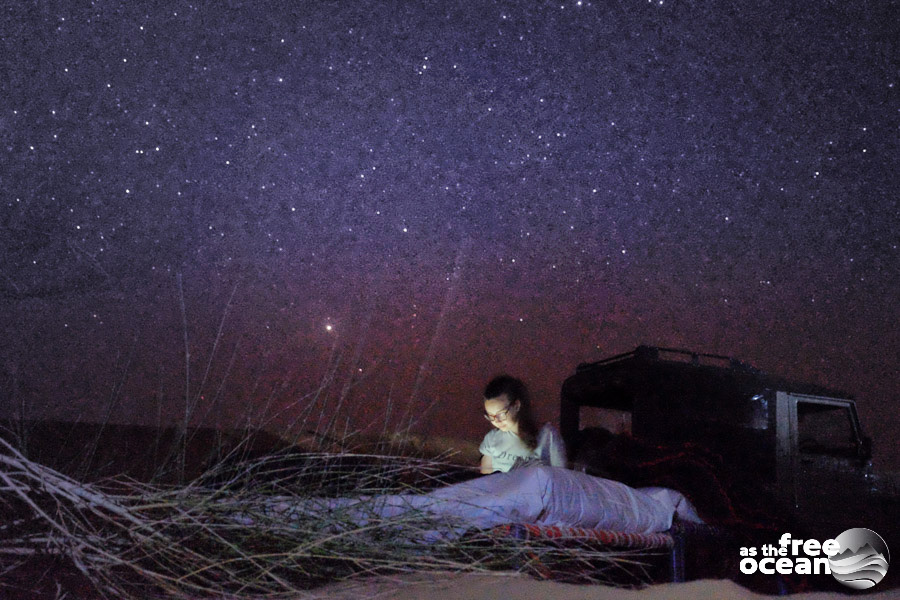
We ate in top-rated restaurants but always happily tried the street food whenever we got the chance to taste something new. We met amazing people that made our trip unforgettable but got in contact with many more that wanted to scam us.
We left India with a confusing mix of emotions, with the need to disconnect from it but also with regrets and the promise to return in the future.
We enjoyed some of its traditions that we took part in, the natural beauty, the energy of its people, the diversity of experiences, the amazing food and we’ve been surprised by the apparently chaotic but still functional social system.
India will probably break your heart if you have eyes to see the poverty around you, might disgust you and, eventually, convince you to leave with the wish to never return. But it might also steal your heart and make you fall in love with the things that define it as a truly incredible place.
More incredible pictures of India you will find in our Gallery.
New Delhi impressed us since the moment we got close to the city while traveling by bus from Agra, with its modern buildings and the complex infrastructure. But the closer we got to the old streets and the touristic areas, the less charm we found.
New Delhi is the capital of India and its second-largest city. We spent here our last three days in the country, before flying home. After 8 months of being constantly on the roads, we decided it was time for a break, mostly after India consumed our last energy reserves.
Moving around in New Delhi
Delhi’s well-organized infrastructure allows locals and tourists to easily move around. One of the most convenient transportation options is the subway, which can bring you faster than other transportation methods to the far placed attractions. Ola Cabs and Uber services are available in the city, but finding a driver always took a very long time so we tried to negotiate directly with the tuk-tuk drivers. Still, we used the apps to understand what the fair prices were, as most tuk-tuk drivers try to rip-off tourists more than in any other place that we visited in India. Another transportation option is the cycle rickshaw, for those who want more of local experience.
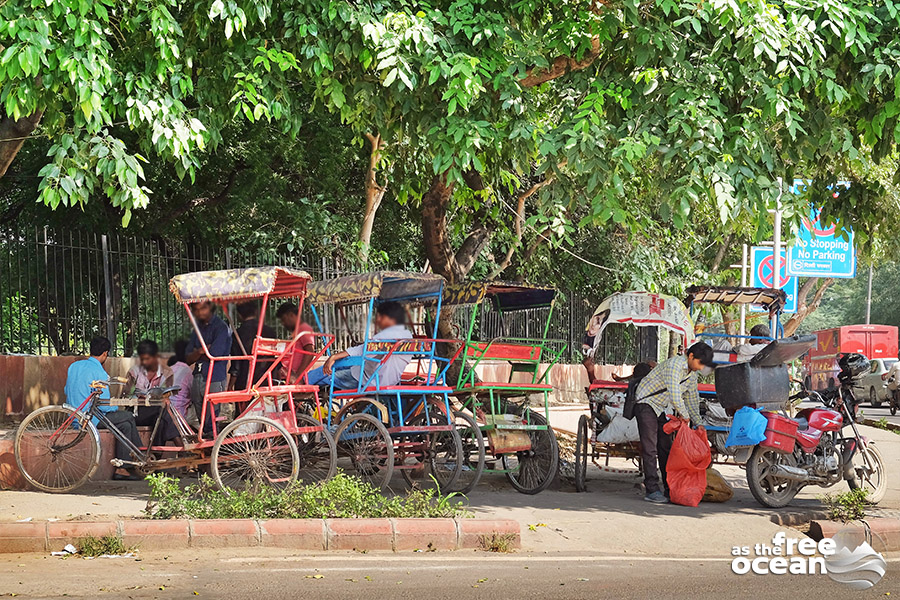
Food, drinks and entertainment in New Delhi
Like most big cities, New Delhi does not disappoint with its large selections of restaurants and coffee shops, local and western style. We opted for the local food, as we knew that once we leave the country we would miss it very much, but we frequently went also to western-style bars and coffee shops, where we knew we could always find a good cappuccino.
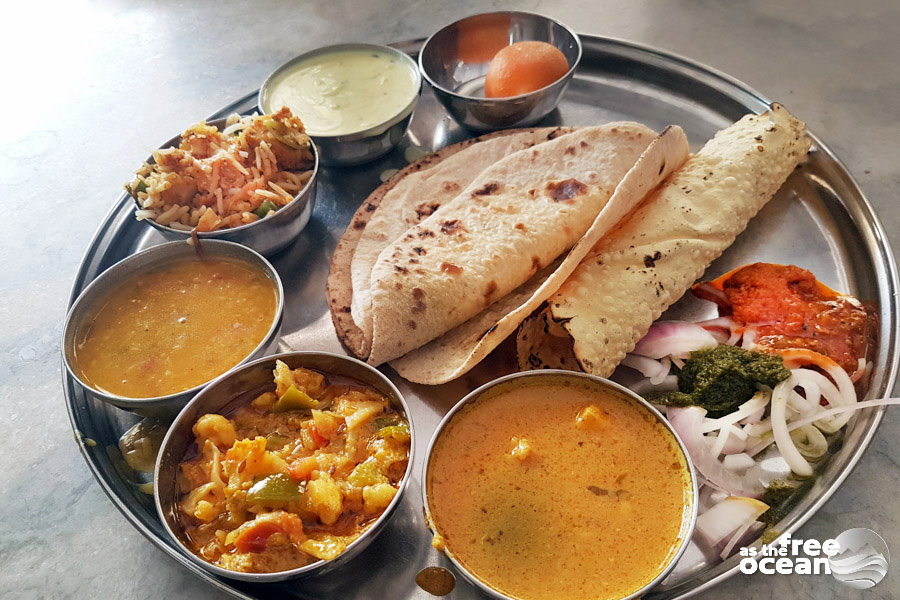
The time in Delhi was short, so we tried to see some of the main attractions, which are many but relatively far from each other. The interest for India’s more recent history brought us to the Gandhi Park, named after the leader of the Indian independence movement against the British rule.
Later that day we visited the Lotus Temple, one of Delhi’s main attractions. But behind its architectural beauty, there are other meanings that make it beautiful. It is a place of worship for all religions, everyone is welcome to enter and pray. But even if praying is not what you search for, it is still a nice place to hide from the hot sun and find a moment of silence, away from the tumult of the surrounding streets.
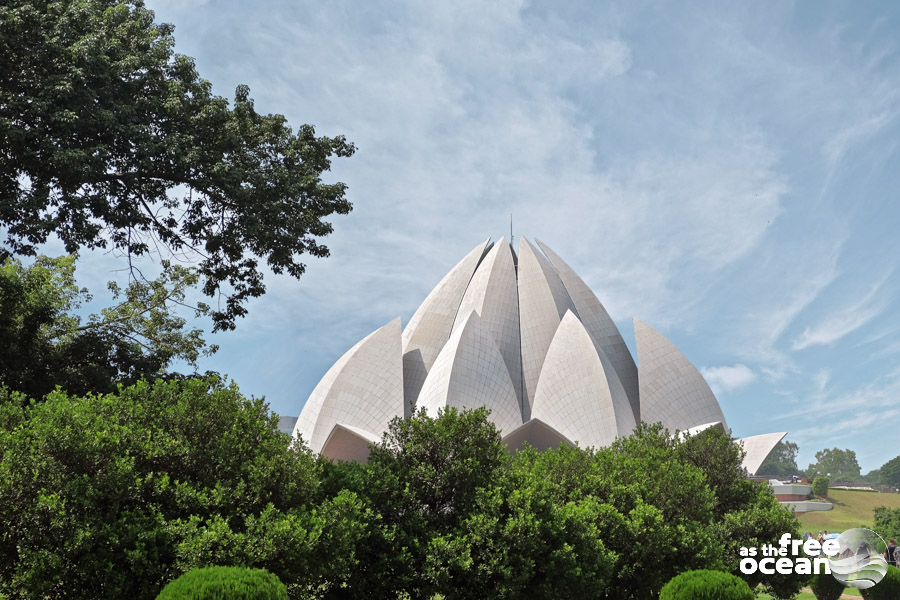
Loosing ourselves on the crowded streets near the Meena Bazar, close to the Jama Masjid Mosque, felt like another “time-travel” experience, where we forgot about the skyscrapers and the modernity of the new part of the city and where we could once again experience India in an authentic way.
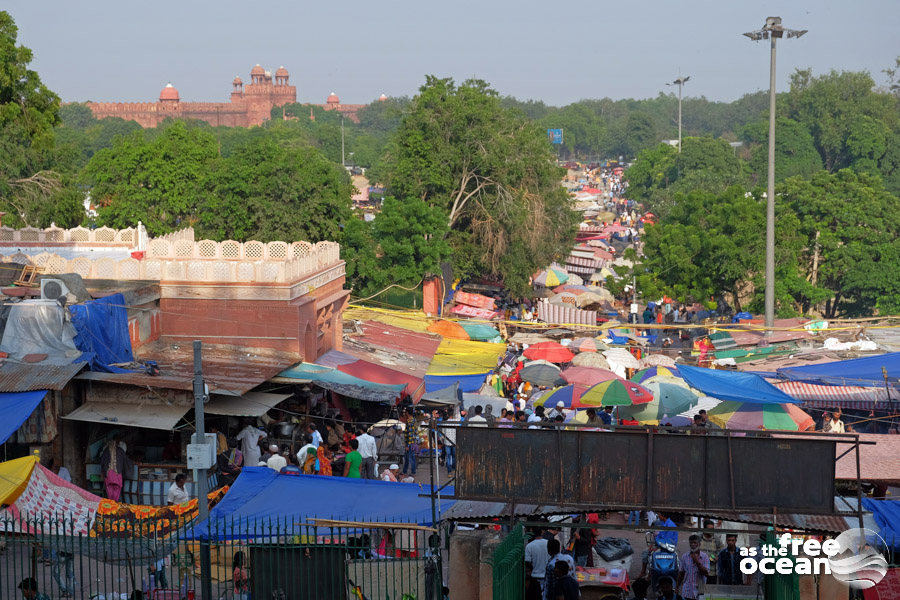
But the most authentic experience we had while walking in the oldest and probably busiest market in India, Chandni Chowk. It is chaotic, congested, dirty and dusty, but beautiful to witness. There we witnessed a captivating show, in which tuk-tuks, cycle rickshaws, cars, pedestrians and cows and dogs competed for space.
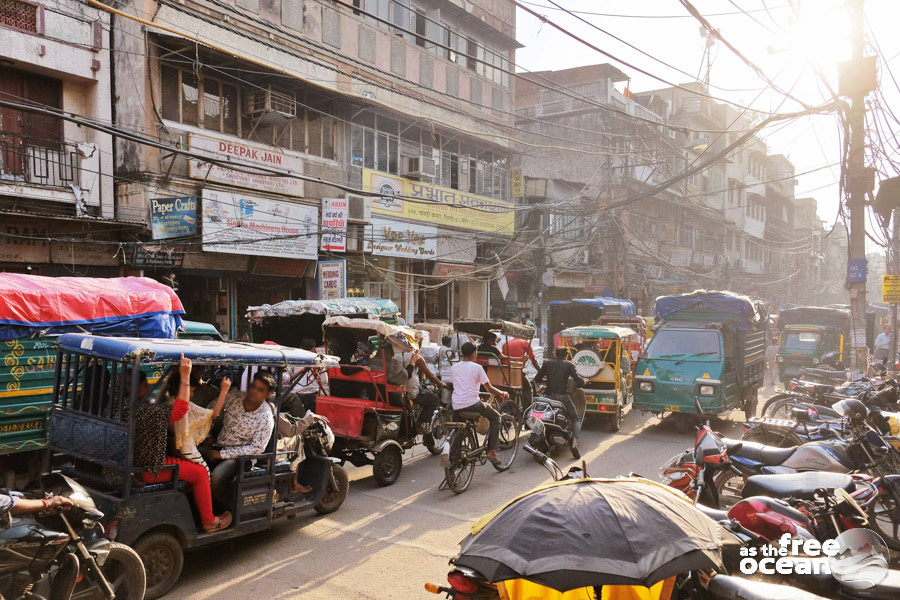
At the end of our stay in New Delhi, we took a flight back to Europe, where we happily met our families and friends again.
Coming back home at the end of any of our travels always felt nice, but going away again has always been an exciting thing to do. We planned to stay for one month at home and soon after travel back to Southeast Asia, choosing as a starting point Thailand.
For more pictures from New Delhi follow this link.
Ever since we arrived in Jaipur, we could feel that we were traveling on a more touristic route. We took the train from Jaipur to Agra, arriving late in the evening in a crowded station and soon after at our hostel, somewhere in the vicinity of Agra’s and India’s most famous landmark, the Taj Mahal.
While most people recommend staying in the city for less than two days, we stopped there for five days. As we could notice from the first morning when we went for a walk to explore the neighborhood, there is little going on in this city and the points of interest are few. But we decided to stop for a longer time due to our work and because we also wanted to have some proper time to rest. Traveling through India can be a very tiring experience and, with so much to see and do, it is advised to travel slowly.
The city of Agra
The Taj Mahal and the Agra Fort are beautiful landmarks to visit, but the rest of the city disappoints with its more than crowded streets (which is not something unusual in India) and the extremely pushy drivers and vendors that constantly try to sell you something, without accepting any form of refusal. They can be very stressful and the closer you get to the touristic areas, the more they manage to lower your enthusiasm. The heavy traffic is another big problem here. We found out from our host that the administration of Agra did not allow people anymore to register tuk tuks in the city, because of the high number of such vehicles on the streets.
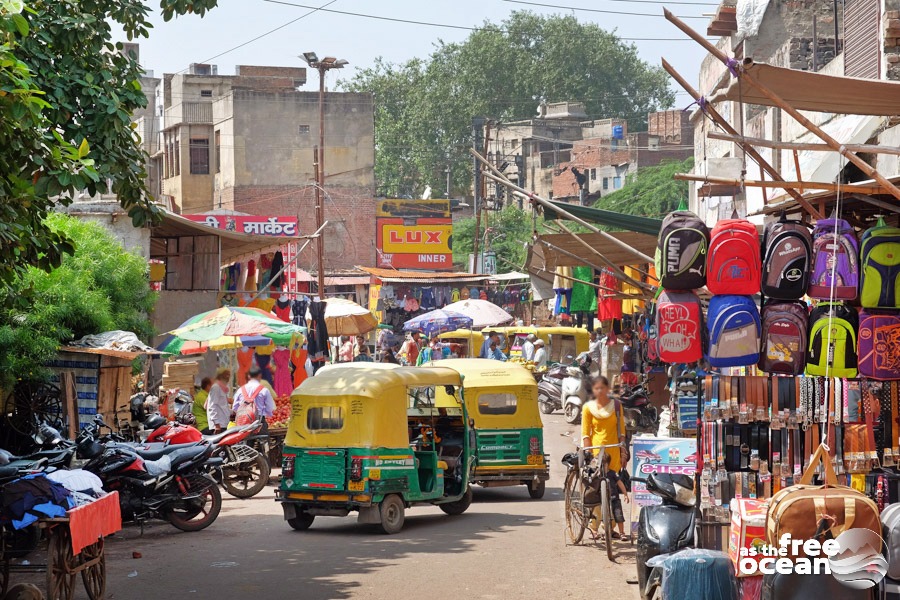
We went through a series of new experience during our stay in Agra, from verbally fighting with people because of their aggressive behavior towards tourists, to seeing a cow entering the restaurant where we were eating and almost joining us for lunch or observing a monkey stealing bananas from the kitchen of the place where we usually had our afternoon coffee. Things were definitely different and we experienced India in a more intense way by the time we got closer to the end of our trip.
The Taj Mahal
The main reason why people travel to Agra is the famous Taj Mahal, probably the most known landmark in India and one of its symbols.
We visited the mausoleum during our third day in Agra. It took us just 15 minutes to walk from our hostel to the entrance gate. It can take longer or less time if you walk, according to how well you manage to respond to the presence of the many people approaching you. If you want to avoid the “friendly locals”, you should know that inside the touristic area you can benefit from free transfers to the entrance gate, in small electric cars.
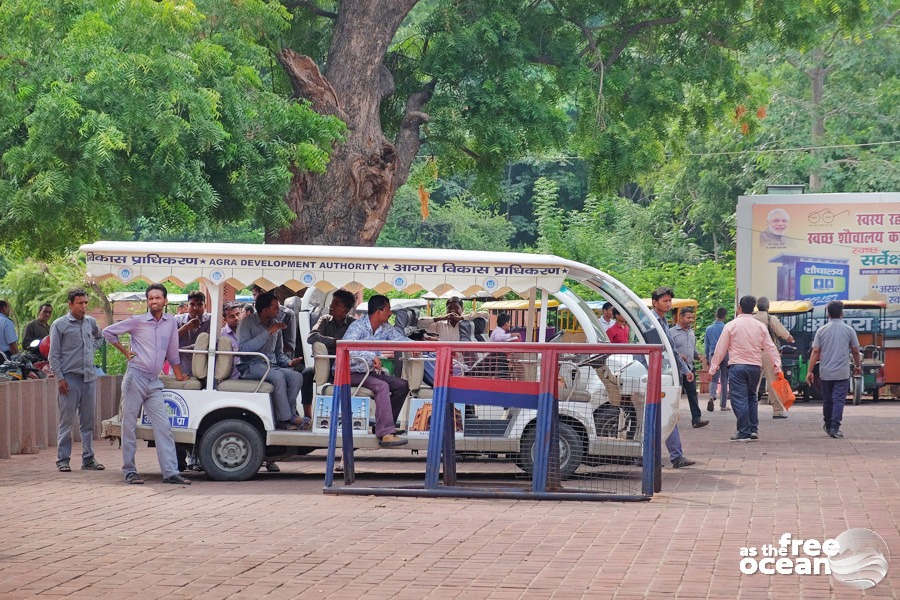
It was still dark outside when we left the hostel, as we planned to be there during sunrise, because of the cooler air in the morning, the lower number of people inside and for the more beautiful atmosphere that surrounded the monument under the morning light. Foreigners are required to pay an entry fee of 1250 rupees (1200 if you pay by credit card) while local people are allowed to enter for free (which probably explains best why the area is always crowded).
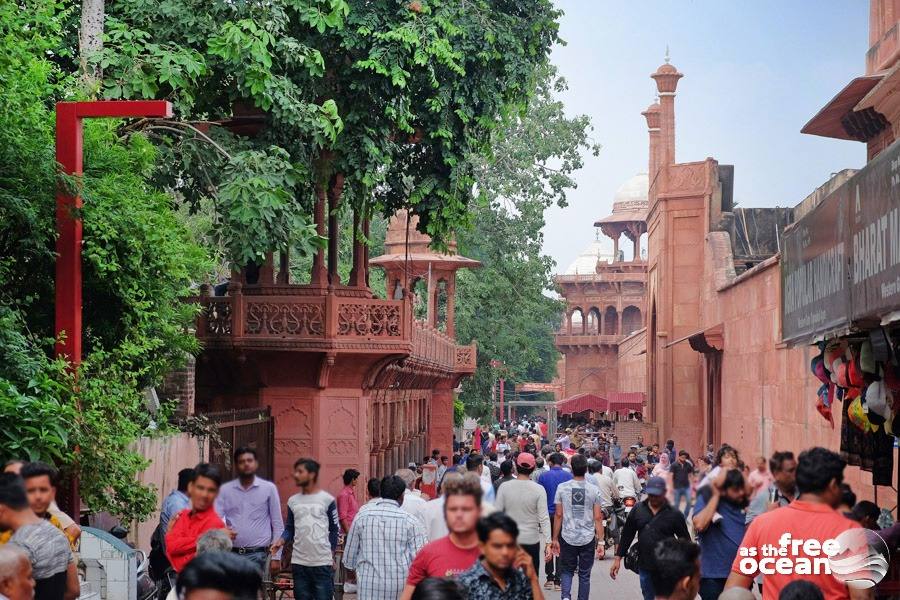
The city disappointed us in many ways, but the Taj Mahal didn’t. It isn’t just an overrated destination, but a truly beautiful one, that deserves all its fame. We passed the giant gate at the entrance and walked towards the garden, where we stood speechless in front of the beautiful mausoleum.
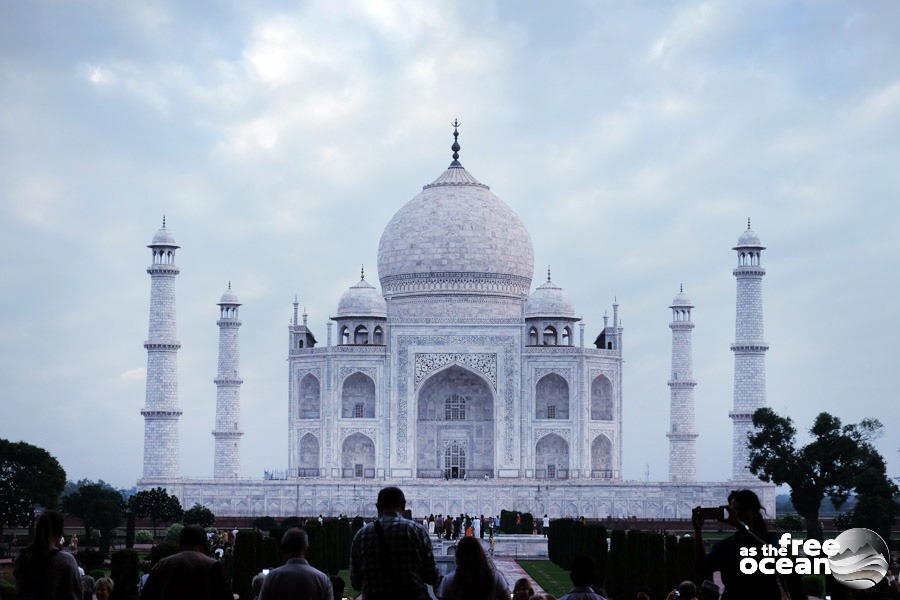
Tons of white marble and precious materials were used for its construction, brought mainly from India, but also from the surrounding countries. The plinth and tomb took approximately 12 years to complete, while another 10 years were necessary for finishing the whole complex, including the large garden, the minarets, the mosque and other architectural details. Nowadays it is considered one of the new wonders of the world.
The story behind the construction of the Taj Mahal is a love story with an unhappy ending. The project was initiated by the Mughal emperor, Shah Jahan in honor of his favorite wife, Mumtaz Mahal, who died giving birth to one of their children. Nowadays, their deceased bodies rest together inside the large tomb of the mausoleum.
As the sun got hotter and the crowds bigger, we decided to leave the area and looked for a place to have breakfast. On the way back we found a restaurant with a terrace overlooking the Taj Mahal.
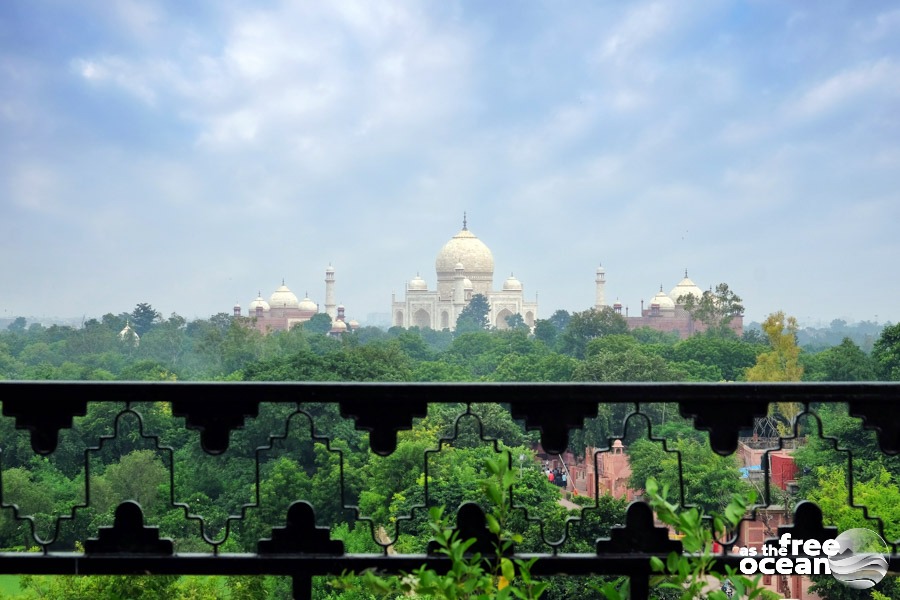
For a better view from outside, we recommend walking around it to the riverside. The viewpoint is indicated on both Google Maps and Maps.Me, the two mobile apps that we are usually using.
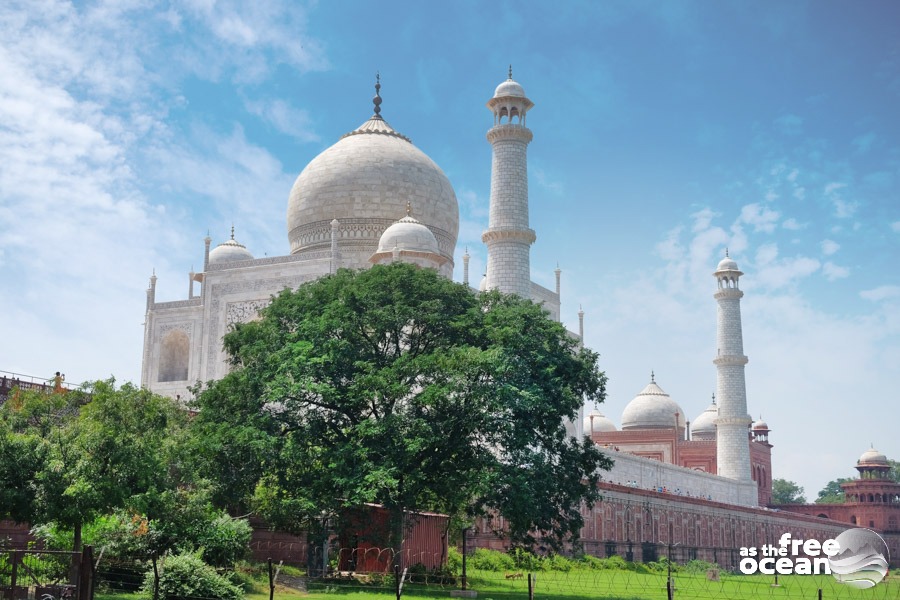
For a different perspective, a tuk-tuk ride could bring you to the other side of the river, from where you can get a good picture without the crowds.
Five days later we were almost at the end of our journey through India. We went to the railway station in Agra to catch the train to New Delhi.
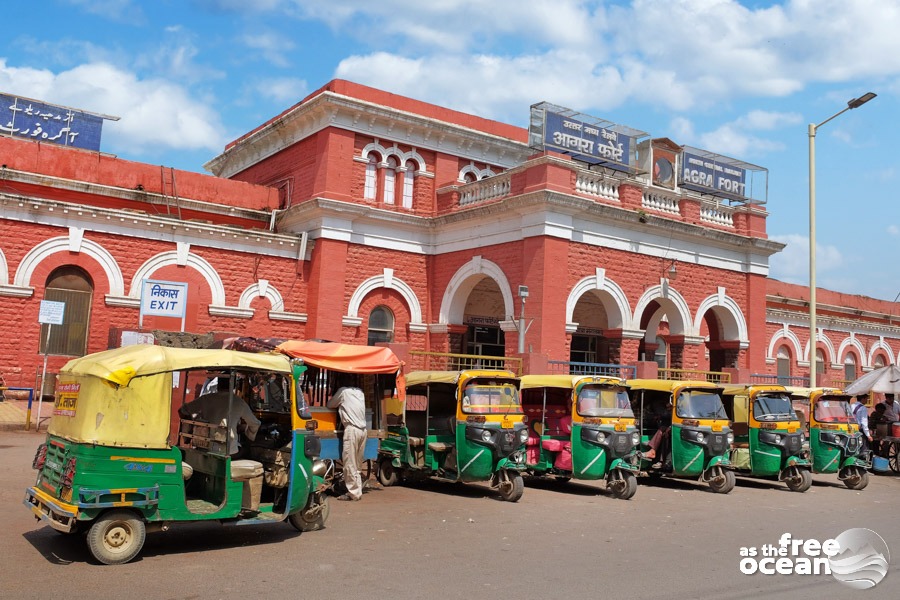
As if Agra didn’t want to let us go, we were informed that the train had a big delay, which brought us to the decision to take a bus, in the hope that we would save some time. The idea seemed good when we arrived at the bus station and instantly boarded the bus that was leaving to Delhi, just to have our expectations lowered by seeing the bus breaking down shortly before we even left the city. Half an hour later another bus came to pick us up.
It took around 4 hours to arrive in Delhi, with a bus whose driver did not even consider making a stop in between for people to use the toilet and who dropped us outside the city at the arrival in New Delhi. We already knew then that the capital city if India would not feel like one of the most welcoming of our destinations.
Check out more pictures of Agra here.
After visiting “The Golden City” Jaisalmer and “The Blue City” Jodhpur, we couldn’t have left the Thar Desert without stopping in the “Pink City”, Jaipur, the capital city of Rajasthan and one of India’s largest cities. It is also one of the three destinations forming the famous Golden Triangle touristic circuit, along with Agra and New Delhi.
The name “Pink City” comes from the dominant color of the buildings on the main avenues, which were painted pink in 1876 to welcome H.R.H. Albert Edward, Prince of Wales.
Things to see in Jaipur
While the city is big and has plenty to offer, we enjoyed it less than the previous two destinations in Rajasthan. Unfortunately, the city gets so crowded with tourists that the locals who work in the tourism industry are more busy trying to scam the visitors than offering them a positive authentic experience. They are less friendly and pushier, some of them even slightly aggressive while trying to convince you to accept their service or to buy their products. But these should not be reasons to avoid visiting the city. There is plenty to see and do. Some of the most important landmarks are beautiful examples of the architectural development in the last centuries, including the Hawa Mahal, the Jal Mahal, the City Palace, the impressive Amer Fort, the Jantar Mantar, the Nahargarh Fort and the Jaigarh Fort.
We managed to see everything we wanted to visit in just one day, by taking a tour with a local tuk-tuk driver. If you don’t feel like taking a tour, it is easy (and probably cheaper) to just book individual rides from one destination to another, as most landmarks are located on a straight line from the city center to the Amer Fort. If you book your accommodation online, most probably you will receive, together with your booking confirmation, a complimentary free tuk-tuk ride to your hotel. The offer usually comes from drivers that only collaborate with different hotels and hostels, hoping to be the first ones to offer tours to the travelers arriving in the city.
The Amer Fort in Jaipur
The Amer Fort was our favorite stop during the tour. It is a massive and impressive construction, made of red sandstone and marble, composed of the main palace and the Jaigarh Fort. The structure is enclosed with walls built on the peaks of the surrounding hills.
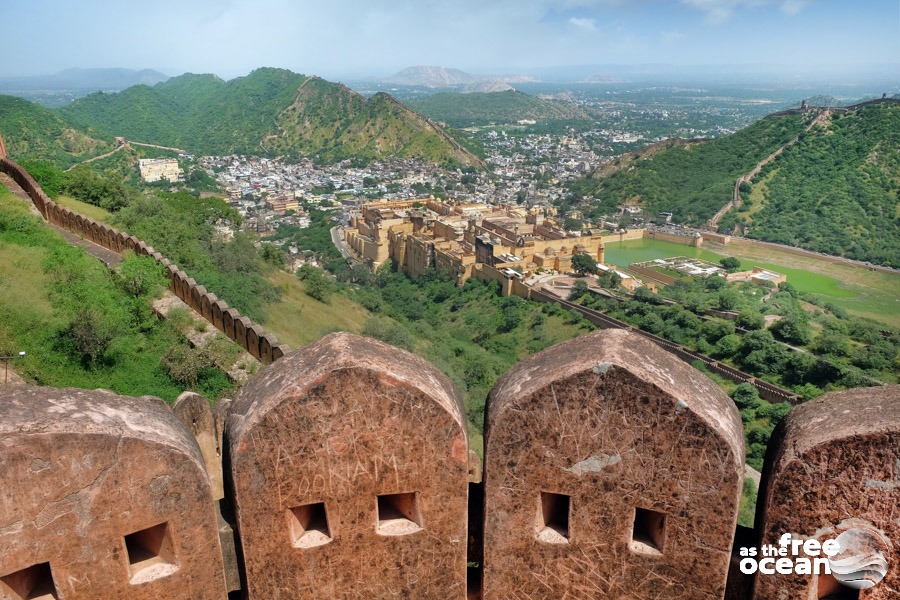
The most beautiful part of it is probably the Amer Palace, which we admired only as we rushed to the top of the Jaigarh Fort, from where we could see the entire valley. The entry ticket was way cheaper than the one for the palace, only 100 Rupees per person.
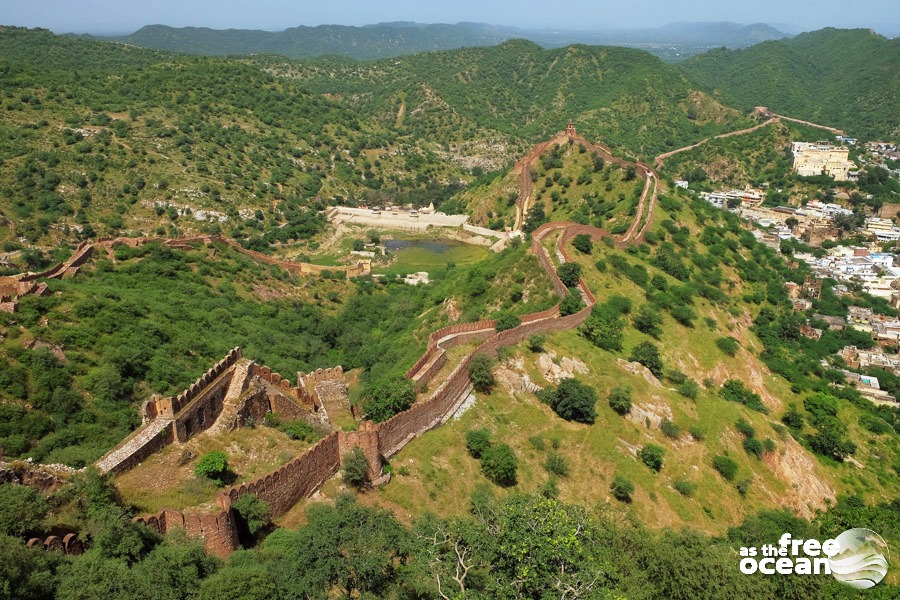
It took us more than two hours to explore the Fort and later in the afternoon we continued our tour towards the Jal Mahal and the Albert Hall Museum, where we had only short stops to take pictures.
Later we arrived at the Monkey Temple, which we don’t necessarily recommend visiting. Apart from the panoramic view from the top, we didn’t find much entertainment in dealing with the terrible smell and seeing badly maintained structures.
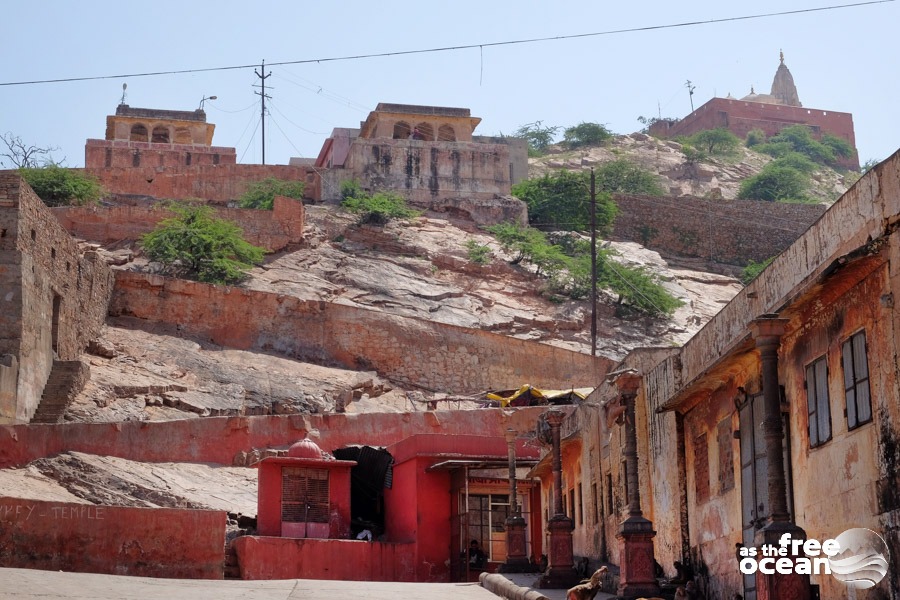
We explored more of the Pink City on our last day while walking on its busy streets, enjoying local coffee and reserving some time to visit the Hawa Mahal.
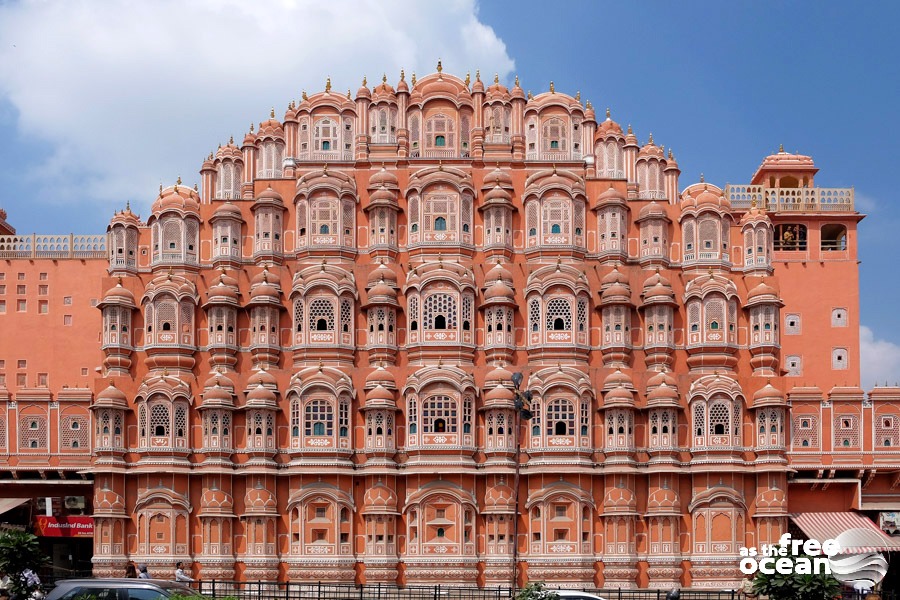
There is much more to see in the city, but as our time in India was getting shorter and shorter, we decided to reserve more days for the last two destinations in the country, Agra and New Delhi.
Check our gallery for more pictures.
DISCLOSURE
Behind the links/banners etc. marked with (*) are affiliate links and advertisements. If you buy something through these links, we will receive a small commission. This will not make the product more expensive for you. We are very happy with your support.
GET IN TOUCH!
Do you have a question, a comment, or do you just have something nice to say? We want to hear from you! Leave us a message and we will reply as soon as possible. Thank you!
E-mail: freeoceantravelers [at] gmail.com
